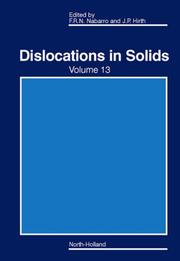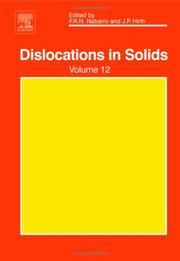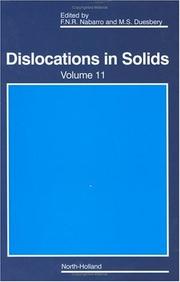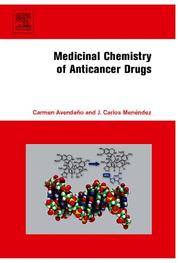| Listing 1 - 10 of 13 | << page >> |
Sort by
|
Book
Year: 1967 Publisher: Oxford : Clarendon Press,
Abstract | Keywords | Export | Availability | Bookmark
 Loading...
Loading...Choose an application
- Reference Manager
- EndNote
- RefWorks (Direct export to RefWorks)
Dislocations in crystals. --- Dislocations dans les cristaux.
Book
Year: 1967 Publisher: Oxford Clarendon Press
Abstract | Keywords | Export | Availability | Bookmark
 Loading...
Loading...Choose an application
- Reference Manager
- EndNote
- RefWorks (Direct export to RefWorks)
Book
Year: 1967 Publisher: Oxford Clarendon Press
Abstract | Keywords | Export | Availability | Bookmark
 Loading...
Loading...Choose an application
- Reference Manager
- EndNote
- RefWorks (Direct export to RefWorks)

ISBN: 1281023558 9786611023553 0080524680 0444518886 9780444518880 Year: 2007 Publisher: Amsterdam : Oxford : Elsevier North Holland ; Elsevier Science [distributor],
Abstract | Keywords | Export | Availability | Bookmark
 Loading...
Loading...Choose an application
- Reference Manager
- EndNote
- RefWorks (Direct export to RefWorks)
Dislocations are lines of irregularity in the structure of a solid analogous to the bumps in a badly laid carpet. Like these bumps they can be easily moved, and they provide the most important mechanism by which the solid can be deformed. They also have a strong influence on crystal growth and on the electronic properties of semiconductors.·Influence of dislocations on piezoelectric behavior·New mechanisms for hardening in twinned crystals·Bringing theories of martensite transformation into agreement·Atomic scale motion of dislocations in electron microscopy·Dislocati
Dislocations in crystals. --- Solid state physics. --- Physics --- Solids --- Crystals, Dislocations in --- Dislocation theory --- Dislocations (Crystals) --- Crystallography --- Crystals --- Deformations (Mechanics) --- Grain boundaries --- Plasticity --- Twinning (Crystallography)
Book
ISBN: 1281279609 1281279641 9786611279646 0080564984 008055962X 0444531661 9780444531667 Year: 2008 Publisher: Amsterdam London Elsevier Science
Abstract | Keywords | Export | Availability | Bookmark
 Loading...
Loading...Choose an application
- Reference Manager
- EndNote
- RefWorks (Direct export to RefWorks)
New models for dislocation structure and motion are presented for nanocrystals, nucleation at grain boundaries, shocked crystals, interphase interfaces, quasicrystals, complex structures with non-planar dislocation cores, and colloidal crystals. A theory for the magnetoplastic effect explains many diverse results of this type. The model has many potential applications for forming processes influenced by magnetic fields. Dislocation model for the magnetoplastic effect New mechanism for dislocation nucleation and motion in nanocrystals New models for the dislocation structur
Dislocations in crystals. --- Solid state physics. --- Physics --- Solids --- Crystals, Dislocations in --- Dislocation theory --- Dislocations (Crystals) --- Crystallography --- Crystals --- Deformations (Mechanics) --- Grain boundaries --- Plasticity --- Twinning (Crystallography)

ISBN: 044451483X 9786610967353 1280967358 0080472540 9780080472546 9780444514837 Year: 2004 Publisher: Amsterdam : Elsevier,
Abstract | Keywords | Export | Availability | Bookmark
 Loading...
Loading...Choose an application
- Reference Manager
- EndNote
- RefWorks (Direct export to RefWorks)
This is the first volume to appear under the joint editorship of J.P. Hirth and F.R.N. Nabarro. While Volume 11 concentrated on the single topic of dislocations and work hardening, the present volume spreads over the whole range of the study of dislocations from the application by Kléman and his colleagues of homotopy theory to classifying the line and point defects of mesomorphic phases to Chaudhri's account of the experimental observations of dislocations formed around indentations. Chapter 64, by Cai, Bulatove, Chang, Li and Yip, discusses the influence of the structure of the core of
Dislocations in crystals. --- Solid state physics. --- Physics --- Solids --- Crystals, Dislocations in --- Dislocation theory --- Dislocations (Crystals) --- Crystallography --- Crystals --- Deformations (Mechanics) --- Grain boundaries --- Plasticity --- Twinning (Crystallography)

ISBN: 9780444509666 0444509666 9786611038854 1281038857 0080530451 Year: 2002 Publisher: Amsterdam Oxford Elsevier Science
Abstract | Keywords | Export | Availability | Bookmark
 Loading...
Loading...Choose an application
- Reference Manager
- EndNote
- RefWorks (Direct export to RefWorks)
Dislocations are lines of irregularity in the structure of a solid analogous to the bumps in a badly laid carpet. Like these bumps, they can be easily moved, and they provide the most important mechanism by which the solid can be deformed. They also have a strong influence on crystal growth and on the electronic properties of semiconductors.
Dislocations in crystals. --- Strengthening mechanisms in solids. --- Materials --- Solids --- Dislocations in crystals --- Strength of materials --- Crystals, Dislocations in --- Dislocation theory --- Dislocations (Crystals) --- Crystallography --- Crystals --- Deformations (Mechanics) --- Grain boundaries --- Plasticity --- Twinning (Crystallography) --- Strengthening mechanisms

ISBN: 9780444528247 0444528245 9780080570327 0080570321 9780080559629 008055962X 9786611279608 6611279601 9780444626677 0444626670 0080564984 0444531661 1281279609 1281279641 9786611279646 Year: 2008 Publisher: Amsterdam : Elsevier,
Abstract | Keywords | Export | Availability | Bookmark
 Loading...
Loading...Choose an application
- Reference Manager
- EndNote
- RefWorks (Direct export to RefWorks)
New models for dislocation structure and motion are presented for nanocrystals, nucleation at grain boundaries, shocked crystals, interphase interfaces, quasicrystals, complex structures with non-planar dislocation cores, and colloidal crystals. A theory for the magnetoplastic effect explains many diverse results of this type. The model has many potential applications for forming processes influenced by magnetic fields. Dislocation model for the magnetoplastic effect New mechanism for dislocation nucleation and motion in nanocrystals New models for the dislocation structur
Oncology. Neoplasms --- Antineoplastic Agents --- Neoplasms --- Cancer --- Drugs --- Pharmaceutical chemistry --- Médicaments --- Chimie pharmaceutique --- chemistry. --- pharmacology. --- drug therapy. --- Chemotherapy --- Design --- Chimiothérapie --- Conception --- Pharmaceutical chemistry. --- Chemistry, Medical and pharmaceutical --- Chemistry, Pharmaceutical --- Drug chemistry --- Medical chemistry --- Medicinal chemistry --- Pharmacochemistry --- Chemistry --- Drug design --- Pharmaceutical design --- Drug development --- Antineoplastic agents --- Chemotherapy. --- Design. --- Treatment --- Dislocations in crystals. --- Solid state physics.

ISBN: 9780080472546 0080472540 9780444514837 044451483X Year: 2004 Publisher: Amsterdam Oxford Elsevier
Abstract | Keywords | Export | Availability | Bookmark
 Loading...
Loading...Choose an application
- Reference Manager
- EndNote
- RefWorks (Direct export to RefWorks)
This is the first volume to appear under the joint editorship of J.P. Hirth and F.R.N. Nabarro. While Volume 11 concentrated on the single topic of dislocations and work hardening, the present volume spreads over the whole range of the study of dislocations from the application by Kľman and his colleagues of homotopy theory to classifying the line and point defects of mesomorphic phases to Chaudhri's account of the experimental observations of dislocations formed around indentations. Chapter 64, by Cai, Bulatove, Chang, Li and Yip, discusses the influence of the structure of the core of a dislocation on its mobility. The power of modern computation allows this topic to be treated from the first principles of electron theory, and with empirical potentials for more complicated problems. Advances in electron microscopy allow these theoretical predictions to be tested. In Chapter 65, Xu analyzes the emission of dislocations from the tip of a crack and its influence on the brittle to ductile transition. Again, the treatment is predominantly theoretical, but it is consistently related to the very practical example of alpha iron. In a dazzling interplay of experiment and abstract mathematics, Kľman, Lavrentovich and Nastishin analyze the line and point structural defects of the many mesomorphic phases which have become known in recent years. Chapter 67, by Coupeau, Girard and Rabier, is essentially experimental. It shows how the various modern techniques of scanning probe microscopy can be used to study dislocations and their interaction with the free surface. Chapter 68, by Mitchell and Heuer, considers the complex dislocations that can form in ceramic crystals on the basis of observations by transmission electron microscopy and presents mechanistic models for the motion of the dislocations in various temperature regimes. While the underlying aim of the study of dislocations in energetic crystals by Armstrong and Elban in Chapter 69 is to understand the role of dislocations in the process of detonation, it has the wider interest of studying dislocations in molecular crystals which are ``elastically soft, plastically hard, and brittle''. Chaudhri in Chapter 70 discusses the role of dislocations in indentation processes, largely on the basis of the elastic analysis by E.H. Yoffe. The special case of nanoindentations is treated only briefly.
Digital
Year: 2007 Publisher: Oxford Elsevier Science [distributor]
Abstract | Keywords | Export | Availability | Bookmark
 Loading...
Loading...Choose an application
- Reference Manager
- EndNote
- RefWorks (Direct export to RefWorks)
Dislocations are lines of irregularity in the structure of a solid analogous to the bumps in a badly laid carpet. Like these bumps they can be easily moved, and they provide the most important mechanism by which the solid can be deformed. They also have a strong influence on crystal growth and on the electronic properties of semiconductors. Influence of dislocations on piezoelectric behavior New mechanisms for hardening in twinned crystals Bringing theories of martensite transformation into agreement Atomic scale motion of dislocations in electron microscopy Dislocation patterns deduced from X-ray diffraction Role of dislocations in friction Dislocation motion in quasicrystals.
| Listing 1 - 10 of 13 | << page >> |
Sort by
|

 Search
Search Feedback
Feedback About
About Help
Help News
News